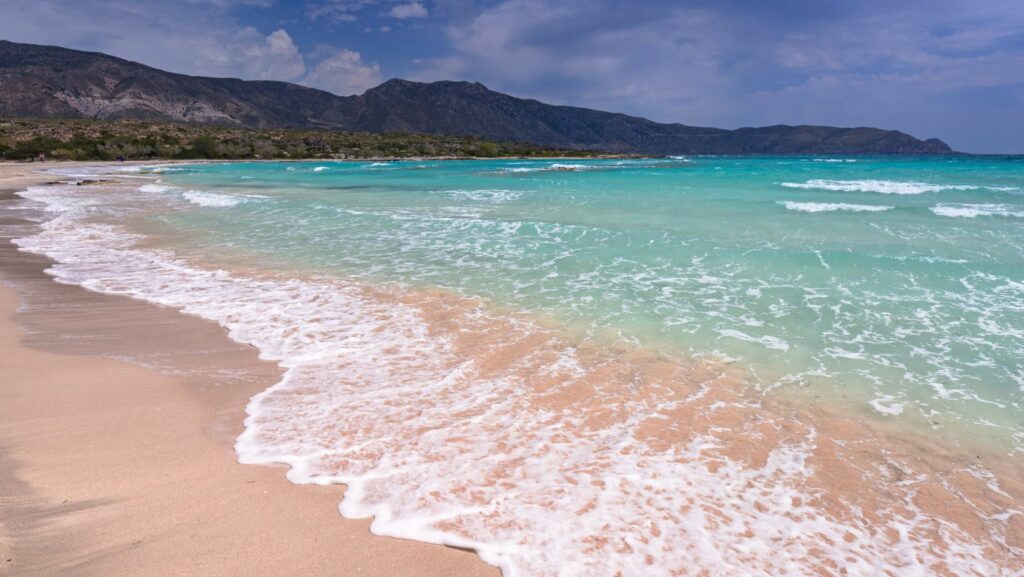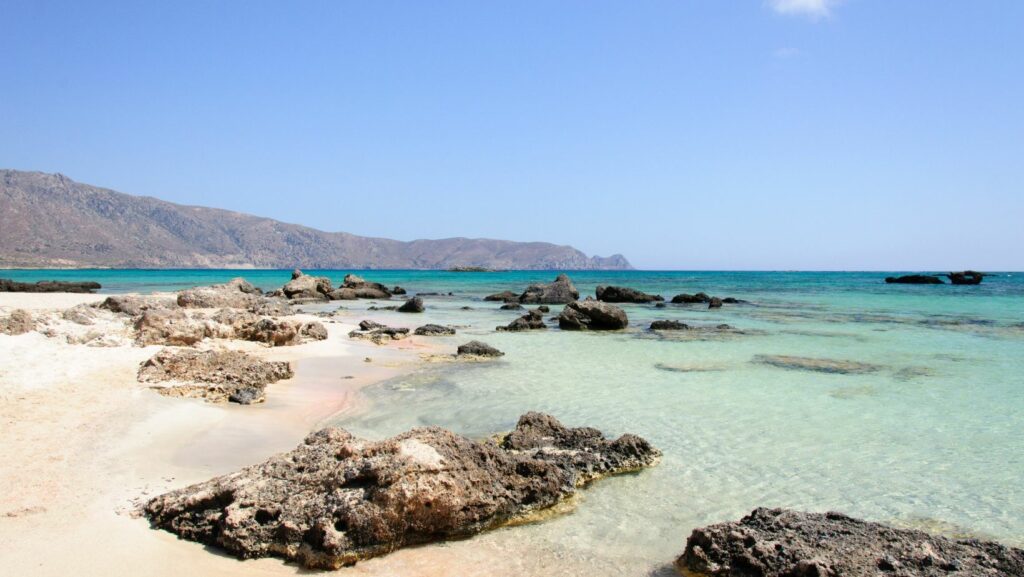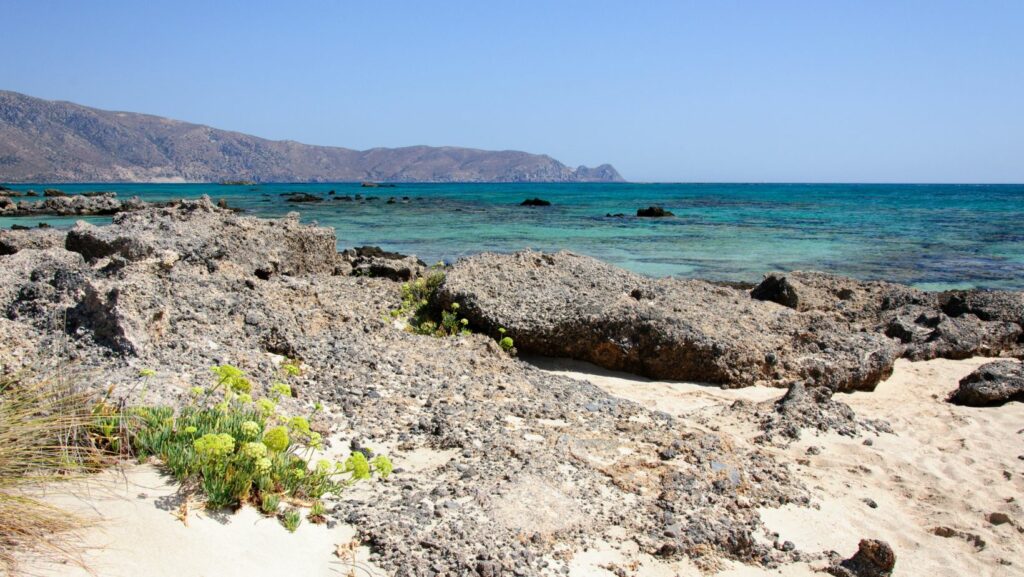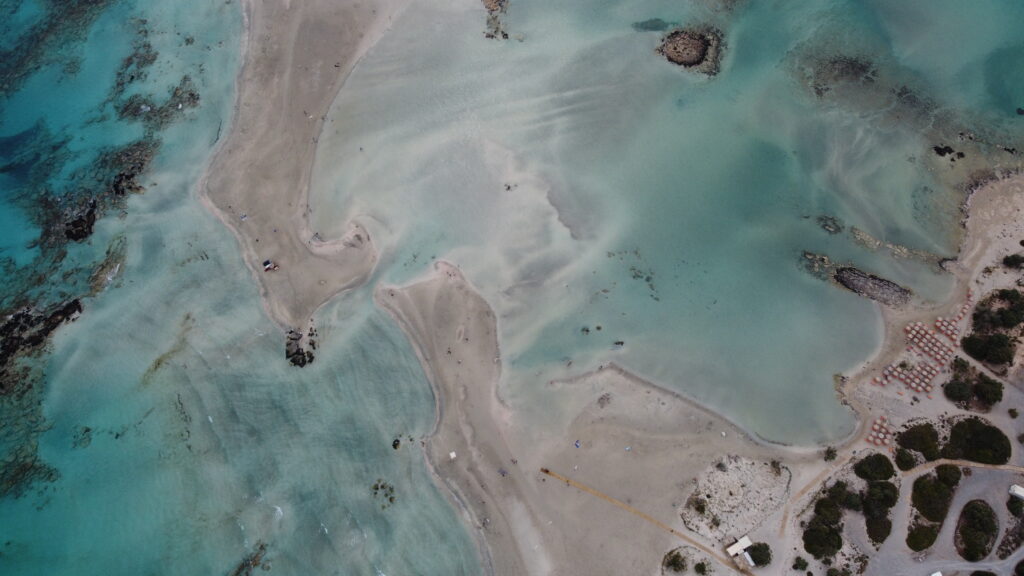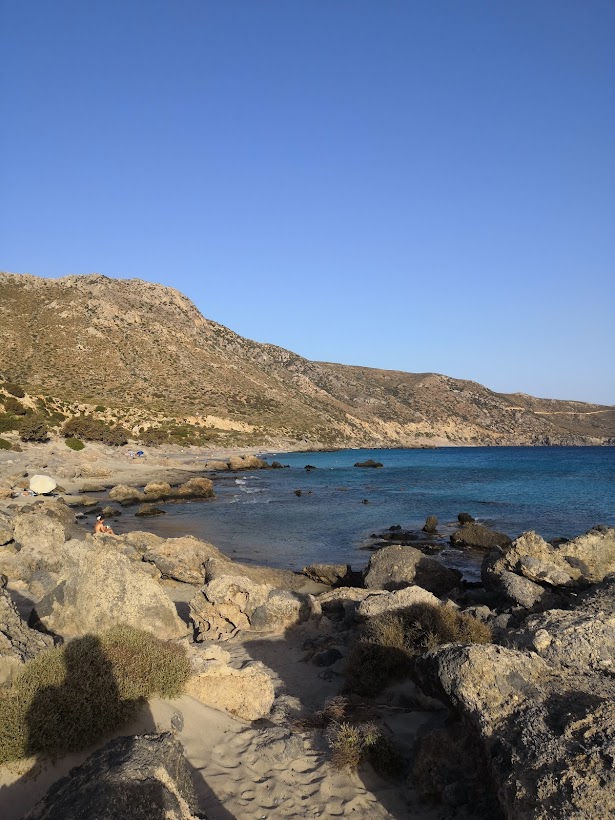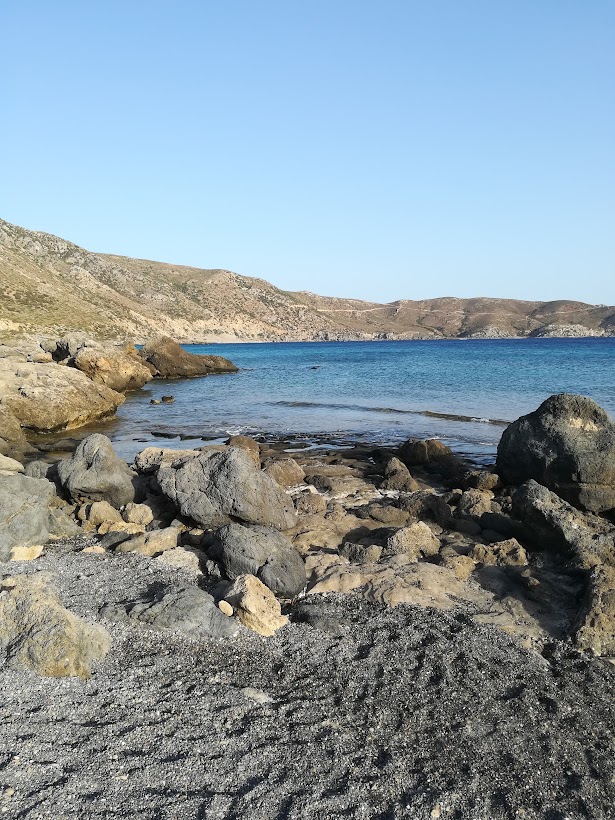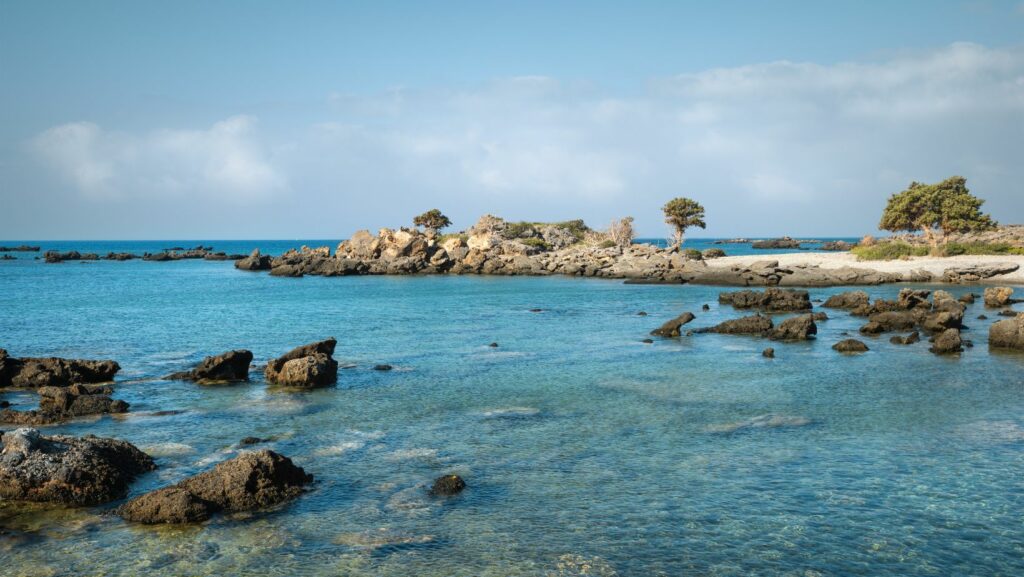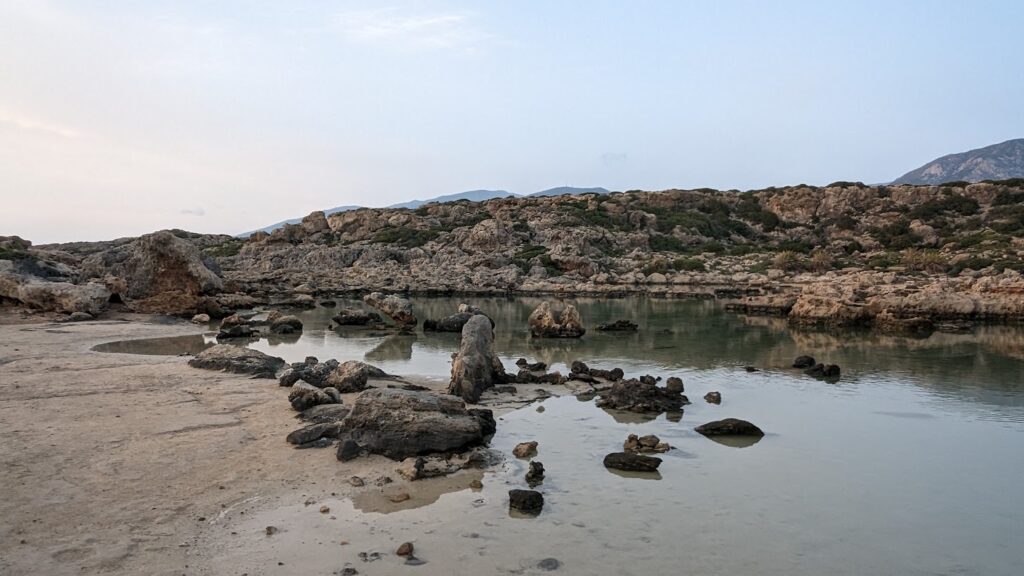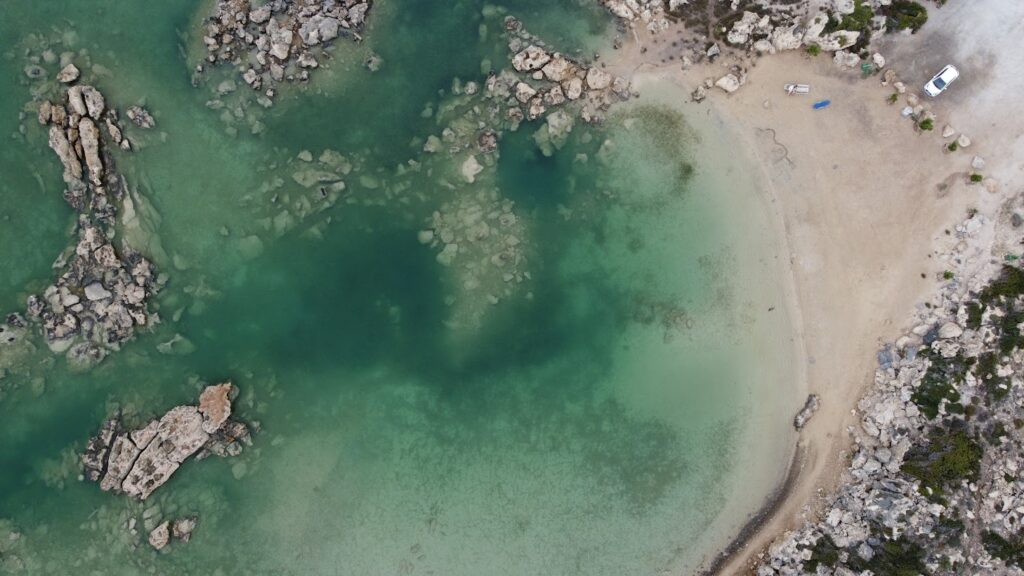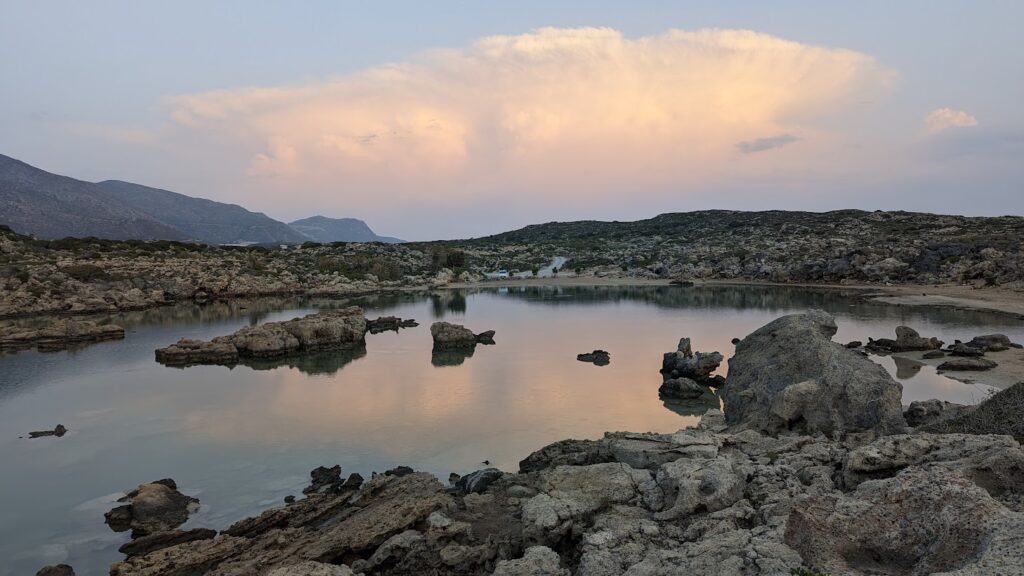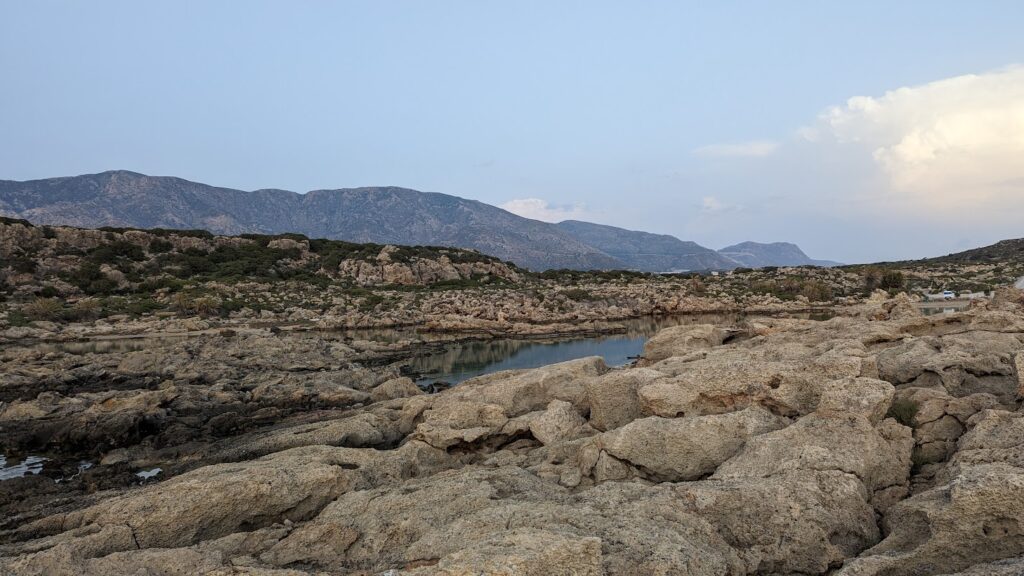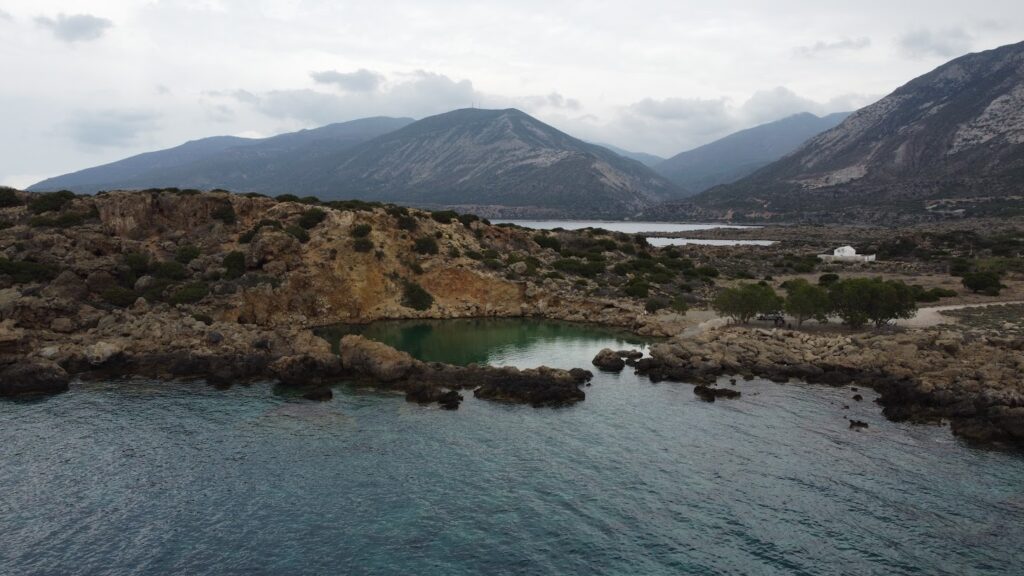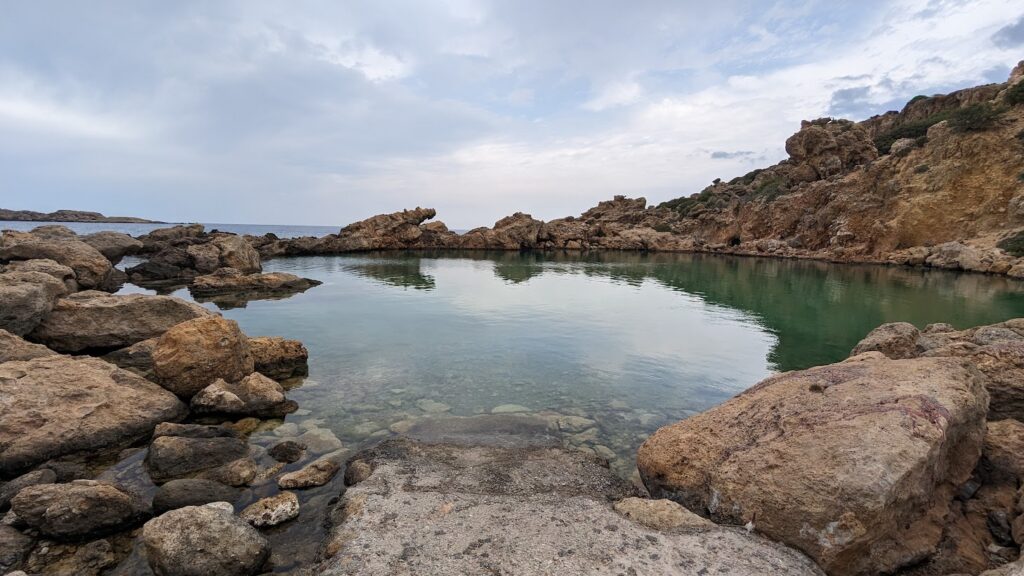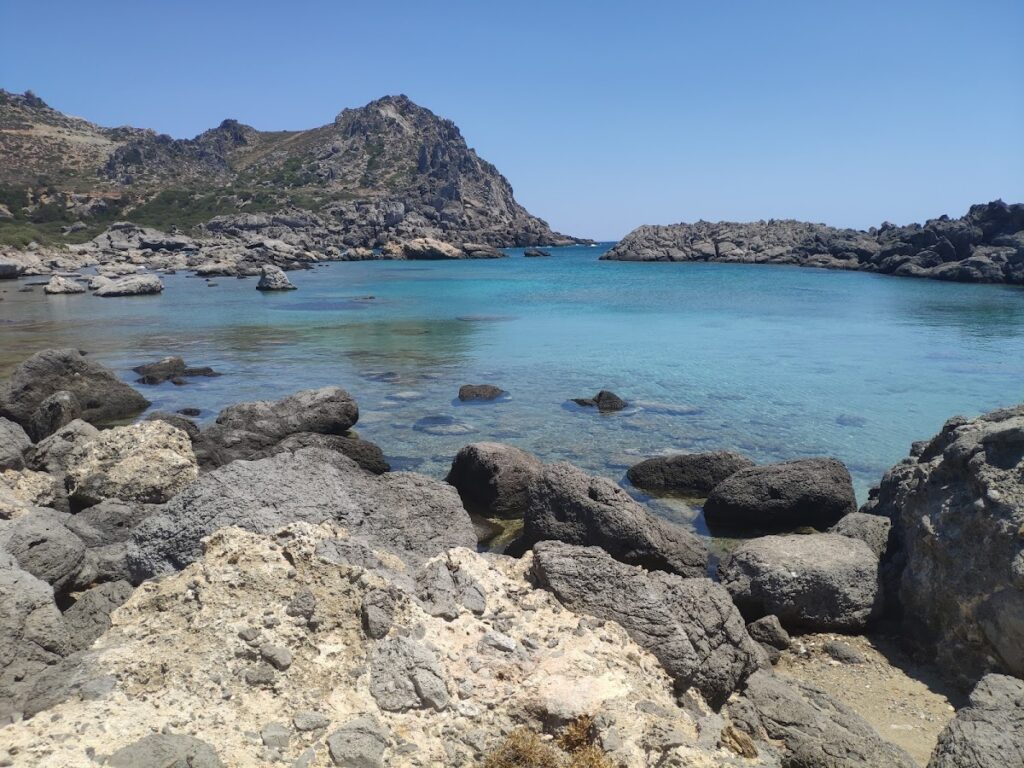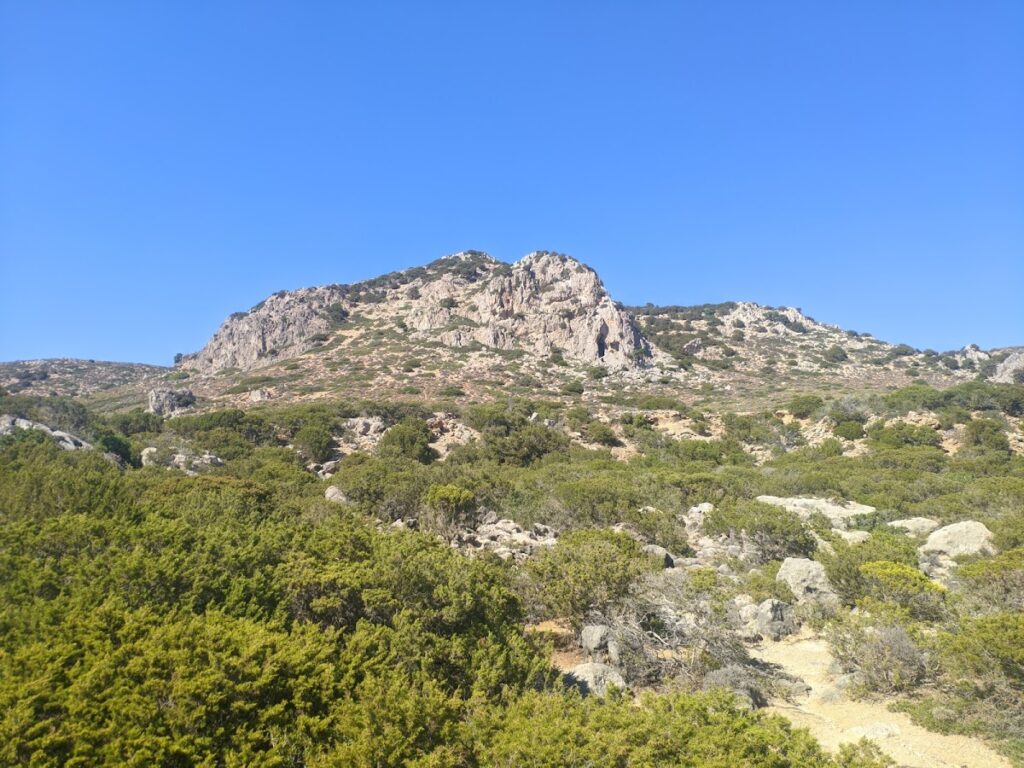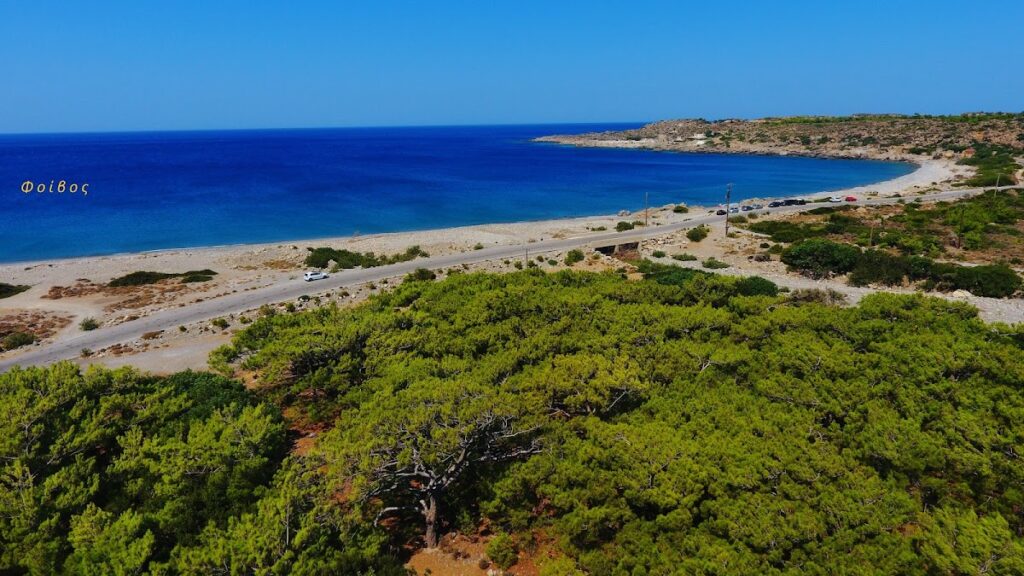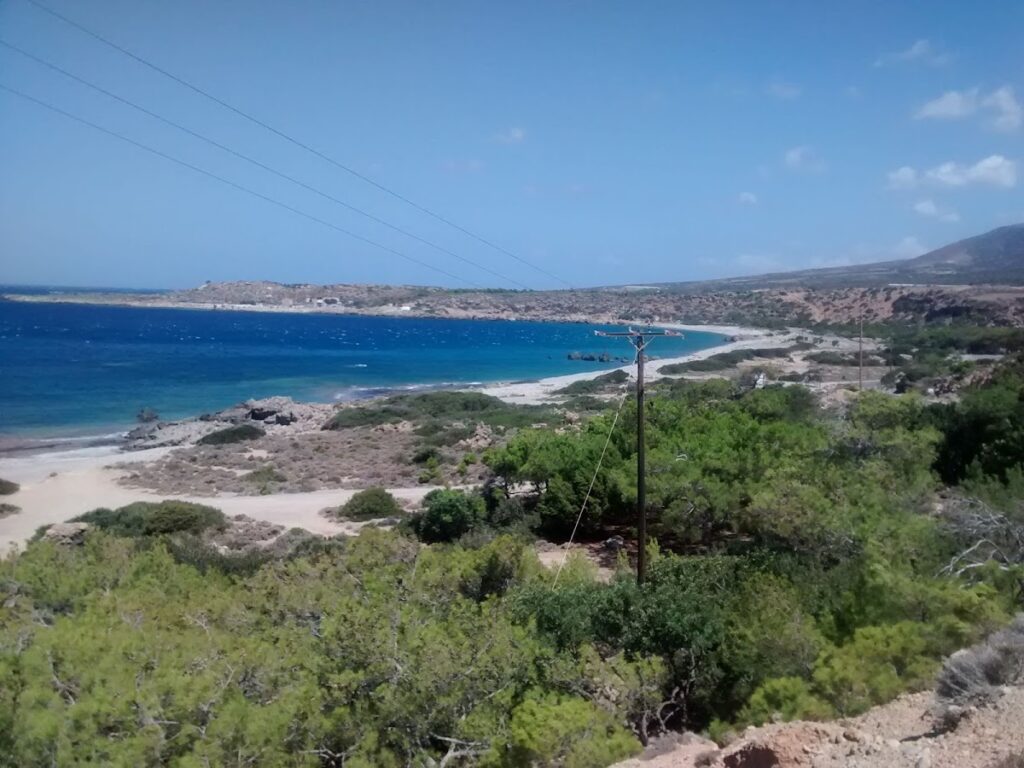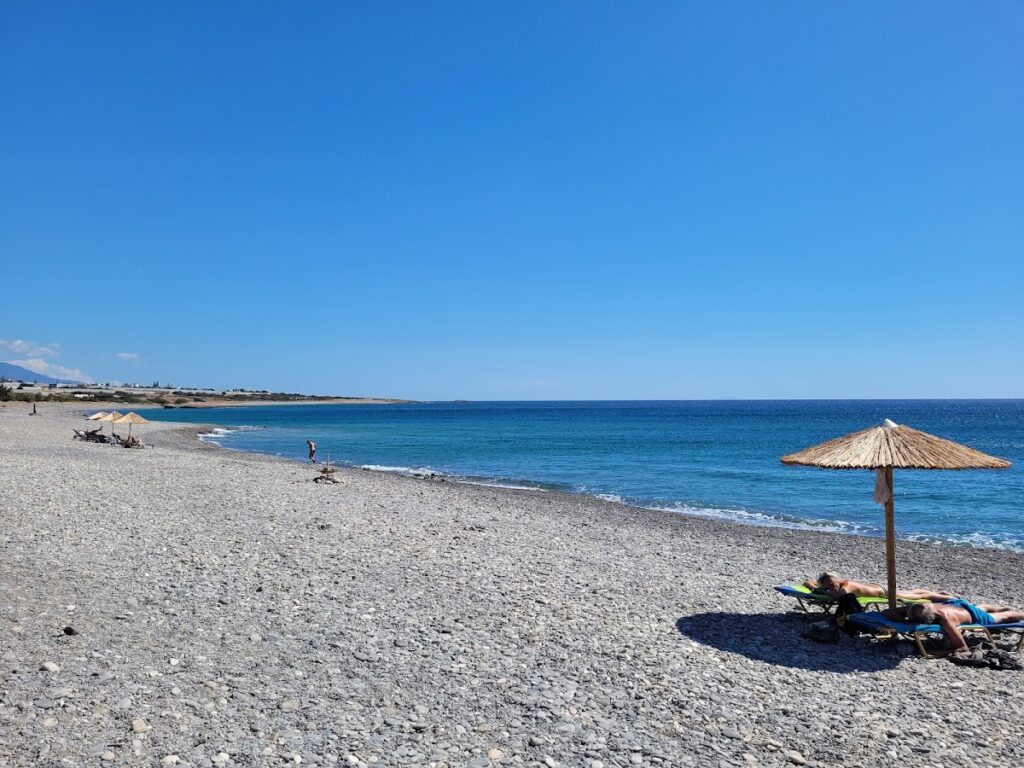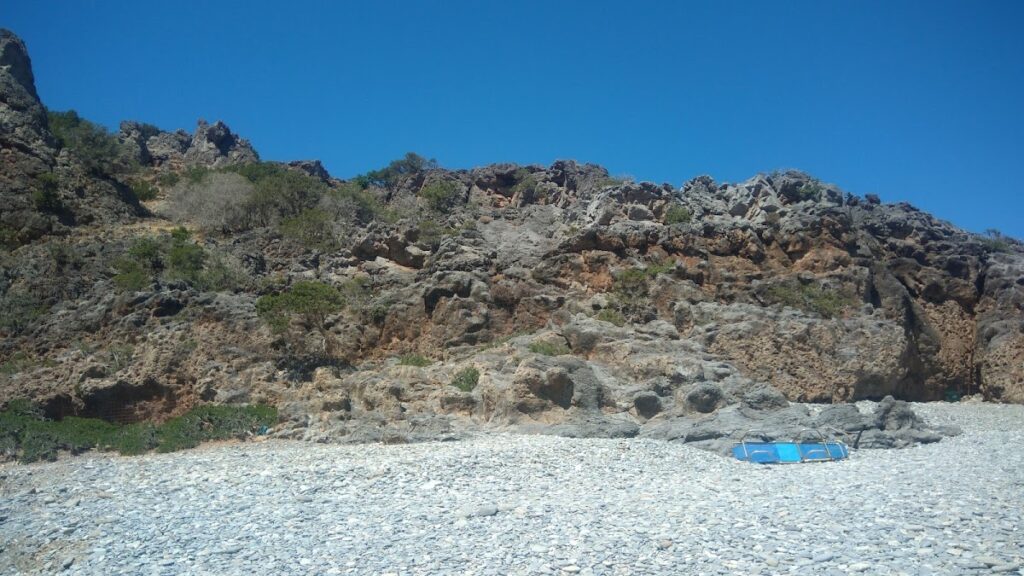Beaches near Elafonísi, in Chania region
Here is list of closest beaches to Elafonísi
- 660 m
- Elafonissi beach
- White Sand
- Shallow
- Turquoise
Elafonissi beach, situated in the southwesternmost point of Crete, is found 76km west of Chania and 5km south of Chrysoskalitisa Monastery. The beach is actually an oblong peninsula that can be separated into two parts by water, giving the illusion of two islands. This area is strictly protected under Natura 2000 regulations due to its abundance of sand dunes, sea daffodils, and junipers. Moreover, this island serves as a sanctuary for several rare species of animals and plants, including the endangered loggerhead sea turtle. As such, visitors are prohibited from removing any plants, animals, shells, or sand from the area.
On both sides of the peninsula, visitors can enjoy exotic beaches that feature white sand and turquoise water, similar to the Caribbean. The sand has a pinkish hue, which is derived from millions of crushed shells. At the peninsula’s breaking point, the seawater is not deeper than 1m, which creates a shallow lagoon ideal for children. Visitors can easily cross the lagoon while carrying their belongings, as the water is quite shallow.
The eastern side of the beach, located in front of the lagoon, is well-equipped and crowded with visitors. Facilities include umbrellas, showers, lifeguards, snack bars, and changing rooms. Nearby, there is a large parking area, as well as a few rooms available for rent. Conversely, the beaches on either side of the peninsula are less populated and are considered the most beautiful due to their mesmerizing azure colours. For those seeking complete seclusion or wishing to go nude, there are some coves available for naturists near the west end of the peninsula.
How to Get to Elafonisi Beach from Chania
Elafonisi is a corner of paradise on the southwestern coast of Crete, included in the top 10 best beaches in the world. To relax on the white and pink sand and swim in the crystal clear sea, guests of Crete come here from all over the island in all possible ways: by car, public transport or as part of an excursion group.
From Chania to Elafonisi by car
It will take at least 1.5 hours to get from Chania to Elafonisi beach. Elafonisi is located 75 km from Chania city. The best option to travel around Crete is on your own, of course, in a rented car with a navigator. There are two ways to get to the beach by car:
-
- Along the west coast on the E65 with wonderful views. The road goes past Kissamos, along serpentines. This round is longer but less stressful.
- Through the mountains and past the Topoli Gorge along the road that cuts through the interior of Crete. First, you need to take the National Highway to Kissamos, then turn left from the E65 highway. This path is shorter but can take longer, as you will have to move along narrow mountain roads.
Both roads are paved and equally picturesque. It is difficult to drive past Elafonisi: all the signs that you will meet along the way lead to it.
From Chania to Elafonisi by bus
Chania is connected to Elafonisi by bus. The KTEL bus departs from the city bus station at 9:00 and returns at 16:00. One-way trip takes about 2 hours. The ticket price is approximately 11 euros. This is a more complicated way than by car.
Another option is to book a guided day trip from Chania to Elafonisi Island, with hotel transfers. In this case, you do not have to worry about the difficulties of the road.
How to get to Elafonisi from Rethymnon
From Rethymno to Elafonisi by car
From Rethymno to Elafonisi is about a 3.5-4 hour one-way drive. Rethymnon city is located 129 km from the famous Elafonisi beach. It is better to leave by car at 5-6 in the morning in order to be in Elafonisi as early as possible. After driving to Chania, you need to keep heading for Kissamos and turn inland or continue along the serpentines along the coast.
From Rethymno to Elafonisi by bus
There are no direct buses from Rethymnon to Elafonisi. But you can get from the Rethymnon bus station to Chania, spend the night in this city, and in the morning take a bus from Chania to Elafonisi.
You have also the option to book a guided day trip from Rethymnon to Elafonisi Island. The trip starts with a hotel pick-up. After arriving at Elafonisi, you will have 4 hours of relaxing on the beach and swimming in crystal-clear waters. Afterwards, you will have time to enjoy lunch at a local tavern before heading back to Rethymnon.
How to get to Elafonisi from Heraklion
The road to Elafonisi from Heraklion will be long. This city is much further from the beach than Chania and Rethymno (210 km), so the best option is to plan a two-day trip.
From Heraklion to Elafonisi by car
Drive along the National Road towards the west to Chania. Then the path follows the same pattern as if you were leaving from Chania.
From Heraklion to Elafonisi by bus
Take a bus from Heraklion bus station to Chania. Here you can get out and go for a walk around the picturesque city, spend the night in Chania, and take a bus to Elafonisi in the morning.
And again you have the option to book a guided trip from Heraklion to Elafonisi.
Other ways to reach Elafonisi Beach
Elafonisi can be reached by sea from Paleochora. Boats leave this village at approximately 10:00 and return at 16:00. Services are provided by both excursion companies and private traders who do not have a set schedule. Due to the fact that it takes as long to get to Paleochora as to Elafonisi, a sea trip will be relevant only for those who are nearby.
The infrastructure of Elafonisi Beach
The beach belongs to the specially protected natural sites of the island, so in this place, you will not find water activities; catering on Elafonisi is represented mainly by kiosks and small bars where you can buy snacks and drinks. There are umbrellas and sun loungers at a fixed price, but it is more convenient (if you are by car) to take sun umbrellas with you, in which case you can choose the part of the beach that you like the most, and not huddle on the most crowded equipped area with other vacationers. Sun protection for adults and children is a must as there is no natural shade.
The beaches of Elefonisi are ideal for families with small children: a gentle descent into the water allows you not to worry about the safety of the kids. In addition, you can swim here even in a storm: due to the shallow depth, there are no big waves on Elefonisi.
Parking, located near the beaches, on the island part of Crete, is free. During the summer months, Elefonisi is wildly popular with tourists, so in order to stroll along the coast in relative seclusion, it is advisable to arrive early in the morning.

- 1.7 km
- Kedrodasos beach
- Rocks in places, White Sand
- Shallow
- Turquoise
Kedrodasos, named for its distinct juniper forest, is a stunning beach located 76km southwest of Chania and just 1km east of the famous Elafonissi lagoon. This beach is dotted with enchanting juniper trees, often confused for cedars, that are beautifully tucked in between sandy dunes. Included species are the twisted Juniperus oxycedrus subsp. macrocarpa and Juniperus phoenicea. Visitors are encouraged to treat these delicate trees with kindness and care.
Covering an impressive area of around 11 hectares, the juniper forest offers a magnificent view. The beach is an ideal spot for swimming and is a favorite among naturists. It features a diverse landscape of white sand and occasional flat, smooth rocks. A lack of nearby amenities emphasizes the secluded allure of Kedrodasos, maintaining it as one of the last untouched havens in Europe. Visitors are encouraged to leave nothing behind, ensuring the beach stays clean and untouched.
Acting as a shield from the regular winds of neighboring Elafonissos, Kedrodasos offers a relatively serene sanctuary. The beach also serves as a stopover for the European E4 trail, with yellow and black markers indicating the way.
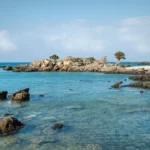
- 4.2 km
- Aspri Limni beach
- Rocks in places, White Sand
- Shallow
- Turquoise
Aspri Limni, translating to ‘White Lake,’ is one of Crete’s most remarkable and yet little-known beaches. Located a mere 500 meters west of Chrysoskalitissa Monastery and 70 kilometres southwest of Chania city, it’s a hidden gem just waiting to be discovered. While many flock to the nearby popular lagoon of Elafonissi, Aspri Limni remains largely unexplored, its beauty preserved in its pristine condition.
The beach, adorned with fine white sand and occasional rocks, is enveloped by jagged cliffs, creating the illusion of a tiny pale lake within the sea. Undisturbed by commercial tourism, Aspri Limni retains its pure and untouched charm, although it lacks natural shade.
To reach Aspri Limni, take a right turn in Chrysoskalitissa village and follow the signs leading to the small Phoenix Theophrasti (Cretan Date Palm) habitat located around the lake. If unsure, any local will be able to guide you to this hidden beach.
Protected under Natura 2000 due to its significance as the westernmost habitat of the endangered Phoenix Theophrasti, Aspri Limni holds environmental importance. This palm species is also found in other groves in Crete such as Vai, Preveli, Agios Nikitas, Souda, and in smaller colonies in South Turkey. Among these, Vai hosts the most extensive palm grove.

- 4.5 km
- Voulolimni beach
- Rocks in places
- Normal
- Green
Situated 70km southeast of Chania and just 500m northwest of the Chrysoskalitissa Monastery, you’ll find Voulolimni – a unique ‘sunken lake’. This is not your typical beach, but rather a natural rocky ‘pool’ that has become a hidden gem for the locals of the Chrysoskalitissa village.
Voulolimni is nestled within a small crater, encircled by rocks, creating a beautiful sea lake. This quaint salt lake is shielded from the strong local winds thanks to its geological formation, with only a small opening connecting it to the open sea. As such, it doubles as a natural harbor for small boats.
Its waters remain calm, boasting an enchanting greenish hue that many swimmers find irresistible. While there are no facilities directly adjacent to the lake, you can find accommodation options and taverns in the nearby Chrysoskalitissa village. This makes Voulolimni a perfect spot for those seeking tranquillity amidst Crete’s natural beauty.
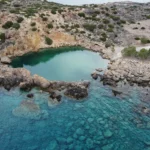
- 5.3 km
- Viena beach Krios Lake
- Rocks in places
- Shallow
- Blue
The Krios or Viena Lake, situated 10km west of Paleochora and 90km south of Chania, is nestled on the European E4 footpath connecting Paleochora and Elafonissi, approximately 20-30 minutes from Krios beach. The beach is predominantly rocky, interspersed with sandy spots, and shielded by a multitude of rocks, forming a small, enclosed bay that locals refer to as a lake (Limni). The area lacks facilities, and there’s only a solitary tamarisk tree on the beach. The Krios Lake beach is one of the most secluded, undiscovered, yet spectacular beaches in Crete.
You might question why such a rugged beach ranks amongst Crete’s most unique beaches. The true allure of this beach isn’t the beach itself, but its proximity to the ancient city of Viena. Marble columns can be seen scattered on the beach and submerged underwater. The beach and its surroundings are strewn with fragments and sherds of urns and amphorae. It’s believed that Viena was once a Hellenistic/Roman sanctuary, with a temple standing here. The rectangular base is still visible. Rituals involving the pouring of wine to honor a deity might have occurred here before or after extensive sea voyages. Centuries ago, the water was deeper, providing a safe anchorage along the otherwise rocky and unwelcoming coastline.

- 5.7 km
- Stomio beach
- Pebbles, Rocks in places
- Deep
- Blue
Stomio, situated 74km to the south of Chania and 1km to the north of the Chrisoskalitissa monastery, forms part of the broader Elafonissi area. It’s not a favorite spot for tourists due to its rocky and often wavy appearance. The beach features large pebbles and patches of sand, making it a suitable choice for those seeking seclusion, though not ideal for families. The water here is rather cold and the sea deep.
The name ‘Stomio’ translates to ‘mouth’ and can be attributed to the river mouth from the village of Vathi that exits at this point. The river’s water is stored in the local reservoir. The beach is not equipped with any amenities, but there is a small tavern close by. The beach is conveniently accessible as it’s adjacent to the main road that links Chania with Chrisoskalitissa and Elafonissi.
Close to Stomio, one can find the old plaster factory, now deserted. There were attempts to revive the factory in 2010, but local residents objected to the financial lobbies and hindered its reestablishment. Also present is the picturesque chapel of Agii Theodori. Across the bay, a lovely pine grove stretches towards the mountain.
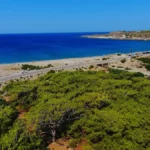
- 6.6 km
- Krios beach, Paleochora
- Pebbles
- Normal
- Deep blue
Krios beach, situated approximately 10km west of Paleochora and 90km south of Chania city, lies on the eastern section of Krios Cape. This charming secluded beach spans around 1km and is split into three consecutive bays filled with fine pebbles and coarse sand.
The easternmost bay, the first of the three, is less ideal for swimming owing to its rocky nature, exposure to southern winds, and lack of amenities. The middle bay, despite being the most frequented part of the beach, maintains a tranquil ambiance. It offers a parking spot, a quaint canteen, and umbrellas. The third beach, a mere two-minute walk to the west of Krios, houses a beautiful small cove concealed by a large rock. This cove is a favourite among nudists, as it provides ample privacy. Umbrellas are available here too, and for those reluctant to pay for one, the nearby rocks form small hollows that provide shade.
You can reach Krios by car via Paleochora. Moreover, Krios is adjacent to a section of the E4 European footpath that connects Paleochora with Elafonisi.
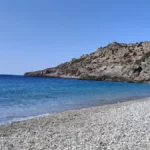
- 8.7 km
- Koundoura beach
- Sand
- Normal
- Blue
Agia Kyriaki beach, also known as Koundoura, is situated 88km south of Chania, 7km west of Paleochora, and a mere 0.5km west of Grammeno peninsula. The beach gets its alternate name from its location in the Koundoura region. The area’s warm climate is ideal for the growth of greenhouse crops.
The relatively secluded Koundoura beach stretches for 700 meters. Despite its proximity to the greenhouses, it’s not a common spot for swimming due to its obscurity. However, it’s an excellent choice for those seeking solitude. While there are no amenities on the beach itself, Grammeno offers several restaurants, a camping site, and a few accommodations.
Access to the beach is possible by car. From Paleochora, drive west towards Krios until you reach Grammenos peninsula. After about half a kilometer, turn left on the road leading to the sea.
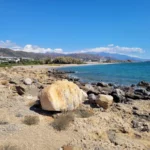
- 9.7 km
- Grammeno beaches, Paleohora
- Pebbles, Sand
- Normal, Shallow
- Blue
The Grammeno peninsula is situated at the mouth of the Pelekaniotis river, 85km southward from Chania and 5km to the east of Paleochora. It lies on the route that links Paleochora with Koundoura. The beautiful Alonaki, Votsalo or Gialos beach with its fine and coarse pebbles as well as its crystalline sea stretches from the eastern part of the peninsula, extending eastwards. The unprotected 500m-long beach is prone to waves, with umbrellas provided on its western part for shade, while the eastern part is more serene.
On the western side of the peninsula, you’ll find the stunning Chouma bay. This sandy cove is well-sheltered and faces west. The Grammeno peninsula is home to a significant colony of protected junipers. While these trees provide shade, they are incredibly fragile and hence should be treated with care. It’s strictly forbidden to break branches, given their slow growth rate of only 1cm per year. Visitors are encouraged to use the umbrellas provided on the beach and avoid any contact with the trees.
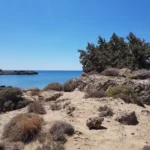
- 10.0 km
- Livadia beaches Kambos
- Pebbles, Rocks in places
- Normal
- Blue
The Livadia coves, nestled near the Livadia village, are situated 72km southwest of Chania and 31km south of Kissamos. These coves don’t usually feature on a visitor’s itinerary due to their rocky and wavy terrain, a characteristic of most beaches on the western side of Crete. However, these coves are a favorite among the locals and visitors of Livadia village and those who prefer solitude. The village offers limited tourist amenities. On calm days, the Livadia coastline is a dream destination for snorkelling enthusiasts.
The Livadia village is situated along the E4 European hiking path – a coastal trail renowned for its extraordinary natural beauty. The trail commences at the Sfinari village and passes through Livadia and Chrissoskalitisa villages before culminating at the Elafonisi beach. The trail embodies the rugged charm of Crete, with the landscape alternating between olive and locust trees and weather-beaten rocks of black and red volcanic lava.
To reach the beaches, one can stroll along the Livadia village shoreline, pass the port, and arrive at the large black rock formations, recognized as a natural monument. Behind these rocks lie clusters of small ponds filled with greenish water. The sandy and pebbly coves make for a perfect spot for a rejuvenating swim. Alternatively, one can also swim at the pebbly beach within the small harbour of Livadia.

No results available
Reset
